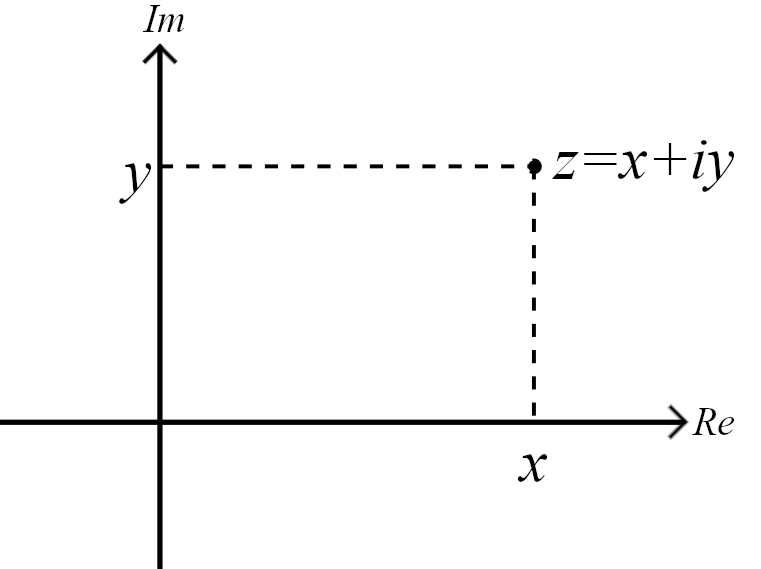2.1 Operations on complex numbers
We can define addition and multiplication on the set of complex numbers in a natural way.
Notice that the definition of multiplication just follows if we multiply \(z_1z_2\) like normal numbers and then substitute in \(\mathrm{i}^2=-1\): \[\begin{aligned} z_1z_2&=(x_1+\mathrm{i}y_1)(x_2+\mathrm{i}y_2)\\&=x_1x_2+\mathrm{i}x_1y_2+\mathrm{i}y_1x_2+\mathrm{i}^2y_1y_2\\ &=x_1x_2-y_1y_2+\mathrm{i}(x_1y_2+x_2y_1). \end{aligned}\]
A complex number is defined by a pair of real numbers, and so we can associate a vector in \(\mathbb{R}^2\) with every complex number \(z=x+\mathrm{i}y\) by \(v(z)=( x, y)\). In other words, we associate a point in the plane with every complex number, and we then call this the complex plane, which is illustrated in Figure 2.1. For example, if \(z=x\) is real, then the corresponding vector lies on the \(x\)-axis. If \(z=\mathrm{i}\), then \(v(\mathrm{i})=(0,1)\), and any purely imaginary number \(z=\mathrm{i}y\) lies on the \(y\)-axis. So we sometimes call these the real and imaginary axes , respectively.

Figure 2.1: Complex numbers as points in the plane: with the complex number \(z=x+\mathrm{i} y\) we associate the point \(\mathbf(v)(z)= (x,y) \in \mathbb{R}^2\).
The addition of vectors corresponds to addition of complex numbers as we have defined it, that is \[v(z_1+z_2)=v(z_1)+v(z_2) ,\] but will seldom use the notation \(v(z)\) in favour of just \(z\).
Multiplication of complex numbers is a new operation which had no correspondence for vectors. Therefore we want to study the geometric interpretation of multiplication a bit more carefully. To this end let us first introduce another operation on complex numbers, complex conjugation .
This corresponds to reflection across the \(x\)-axis. Using complex conjugation we find \[z\bar z=(x+\mathrm{i}y)(x-\mathrm{i}y)=x^2-\mathrm{i}xy+\mathrm{i}yx+y^2=x^2+y^2=\lVert v(z)\rVert^2.\] So we can find the norm of the vector representation of \(z\) by using the complex conjugate. In the complex number setting we usually call this the modulus of \(z\) and denote it by \[\lvert z\rvert:=\sqrt{\bar z z}=\sqrt{x^2+y^2} .\]
Complex conjugation is useful when dividing complex numbers: for \(z\neq 0\) we have \[\frac{1}{z}=\frac{\bar z}{\bar z z } =\frac{\bar z}{\lvert z\rvert^2}=\frac{x}{x^2+y^2}-\mathrm{i}\frac{y}{x^2+y^2} .\] and so, for example \[\frac{z_1}{z_2}=\frac{\bar z_2z_1}{\lvert z_2\rvert^2} .\]
We have \((2+3\mathrm{i})(4-2\mathrm{i})=8-6\mathrm{i}^2+12 \mathrm{i}-4\mathrm{i}=14+8\mathrm{i}\).
We have \(\displaystyle\frac{1}{2+3\mathrm{i}}=\frac{2-3\mathrm{i}}{(2+3\mathrm{i})(2-3\mathrm{i})}=\frac{2-3\mathrm{i}}{4+9}=\frac{2}{13}-\frac{3}{13} \mathrm{i}\).
We have \(\displaystyle \frac{4-2\mathrm{i}}{2+3\mathrm{i}}=\frac{(4-2\mathrm{i})(2-3\mathrm{i})}{(2+3\mathrm{i})(2-3\mathrm{i})}=\frac{2-10\mathrm{i}}{4+9}=\frac{2}{13}-\frac{16}{13} \mathrm{i}\).